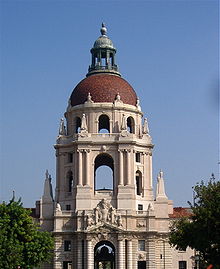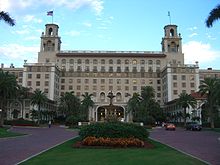- Mediterranean Revival architecture
-
 The Pasadena City Hall located in Pasadena, California is an example of the grandeur of the City Beautiful fashion.
The Pasadena City Hall located in Pasadena, California is an example of the grandeur of the City Beautiful fashion.
The Mediterranean Revival was an eclectic design style that was first introduced in the United States about the end of the nineteenth century, and became popular during the 1920s and 1930s. The style evolved from renewed interest in the Italian Renaissance architecture of palaces and seaside villas dating from the sixteenth century, and can be found mainly in the states of California and Florida due to the popular association of these coastal regions with Mediterranean resorts.
Architects August Geiger and Addison Mizner did much to popularize this style in Florida; while Bertram Goodhue, Sumner Spaulding, and Paul Williams did likewise in California. Structures are typically multi-story and based on a rectangular floor plan, and feature massive, symmetrical primary façades. Mediterranean Revival is characterized generally by stuccoed wall surfaces, flat or low-pitched terra cotta and tile roofs, arches, scrolled or tile-capped parapet walls and articulated door surrounds. Feature detailing is occasionally executed with keystones.
Balconies and window grilles are common, and are generally made of wrought iron or wood. Ornamentation can be simple or dramatic, and may use various Mediterranean references. Classical, Spanish Renaissance, Spanish Colonial, and Beaux-Arts architecture details are often incorporated into the design, as are lush gardens.
The style was most commonly applied to hotels, apartment buildings, commercial structures, and even modest residences. Mediterranean Revival was one of several architectural styles used extensively by the Atchison, Topeka and Santa Fe and Southern Pacific Railroad companies when designing their train stations in California.
List of example structures
- Hayes Mansion in San Jose, California, completed in 1905.
- Villa Vizcaya in Miami, Florida, completed in 1914.
- Presidio Building 35 in San Francisco, California, completed in 1912
- The Ambassador Hotel in Los Angeles, California, 1921 (demolished).
- Temple Terrace Country Club in Temple Terrace, Florida, completed in 1921.
- (Former) Southern Pacific Railroad Depot in Glendale, California, completed in 1923.
- Freedom Tower in Miami, Florida, completed in 1925.
- Vinoy Park Hotel in St. Petersburg, Florida, completed in 1925.
- Boca Raton Resort & Club in Boca Raton, Florida, completed in 1926.
- Miami-Biltmore Hotel in Coral Gables, Florida, completed in 1926
- Fort Harrison Hotel in Clearwater, Florida, completed in 1926
- Cà d'Zan, former John Ringling estate in Sarasota, Florida, completed in 1926.
- Francis Marion Stokes Fourplex in Portland, Oregon, completed in 1926.
- Pasadena City Hall in Pasadena, California, 1927
- Francis Lederer residence, in West Hills, Los Angeles, California, completed 1936.[1]
- 'Greenacres' (Former Harold Lloyd Estate) in Beverly Hills, California, completed in 1928.
- Casa Casuarina (Versace Mansion, now known as The Villa By Barton G.) in Miami Beach, Florida, 1930
- Santa Fe Railway (now Amtrak and Metrolink) depot in Fullerton, California, completed 1930.
- Beverly Hills City Hall, Beverly Hills, California, 1932.
- Cabrillo Beach Bath House in San Pedro, California, completed 1932.
- (Former) Santa Fe Railway Depot in Orange, California, completed 1938.
- Beverly Shores Railroad Station, 1928.
- Snell Arcade in St. Petersburg, Florida. 1925.
- Winter Park Ninth Grade Center 1927.
- Mildred Building, Beaumont, Texas 1929
See also
- Gothicmed-project which includes finding further insight to Gothic architecture in the Mediterranean area
- Mission Revival Style architecture
- Spanish Colonial style architecture
- Spanish Colonial Revival Style architecture
- Moorish Revival architecture
References
- Gustafson, Lee and Phil Serpico (1999). Santa Fe Coast Lines Depots: Los Angeles Division. Acanthus Press, Palmdale, CA. ISBN 0-88418-003-4.
- Newcomb, Rexford (1992). Mediterranean Domestic Architecture for the United States. Hawthorne Printing Company, New York, NY. ISBN 0-926494-13-9.
- Signor, John R. (1997). Southern Pacific Lines: Pacific Lines Stations, Volume 1. Southern Pacific Historical and Technical Society, Pasadena, CA. ISBN 0-9657208-4-5.
- Nolan, David. The Houses of St. Augustine. Sarasota, Pineapple Press, 1995.
- book/author=Nylander, Justin A. "Casas to Castles: Florida's Historic Mediterranean Revival Architecture", Schiffer publishing year 2010. isbn=9780764334351
Revival styles in Western architecture and decorative arts International Baroque Revival · Beaux-Arts · Neo-Byzantine · Carpenter Gothic · Châteauesque · Egyptian Revival · Gothic Revival · Greek Revival / Neo-Grec · Moorish Revival · Neoclassical · Renaissance Revival / Italianate · Romanesque Revival · Second EmpireBritish Empire Bristol Byzantine · Edwardian Baroque · Indo-Saracenic Revival · Jacobethan · Queen Anne Style · Scots Baronial Style · Tudor RevivalFrance Germany Greece Portugal Russian Empire and USSR Scandinavia Spain United States Jeffersonian architecture · American Renaissance · Colonial Revival · Mayan Revival · Mediterranean Revival · Mission Revival · Pueblo Revival · Queen Anne Style · Richardsonian Romanesque · Spanish Colonial Revival · Territorial RevivalCategories:- Mediterranean Revival style architecture
- American architectural styles
- Revival architectural styles
Wikimedia Foundation. 2010.


